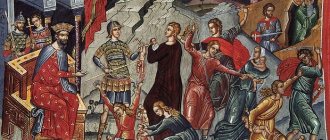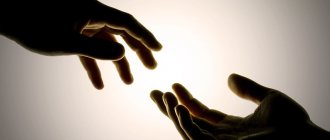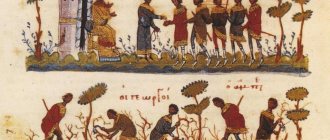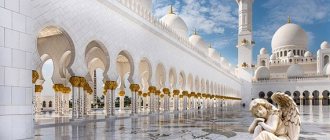Christianity in art goes back about two thousand years. Despite the fact that experts began studying it only from the middle of the 19th century, many shrines were discovered in Italian banking houses starting from the 11th century.
Christianity in art is represented by icons, frescoes, mosaics, monumental painting, book culture and other unique examples. Familiarization with them is interesting for both novice amateurs and art experts.
Early Christian art
The development of early Christian art took place under the strong influence of Ancient Rome. It contains a basilica - an analogue of the Roman architectural type, a modification of some iconographic images and motifs.
Until the drafting of the Edict of Milan, which granted freedom of religion to Christians (312-313), Christianity did not have an original architecture. The first works include wall paintings in Roman catacombs, reliefs of tombs, and decorations in ritual rooms.
Christian wall paintings in the Roman catacombs
A little later, the formation of a Christian temple structure begins. The form of the basilica was adapted from ancient Roman architecture. The buildings of varying sizes were rectangular in shape and consisted of an odd number of naves separated by columns or pillars. In the central part for worship there was an altar, which was decorated with sculpture, gold, and jewelry.
Early Christian art includes:
- temple mosaic;
- relief compositions of sarcophagi;
- reliquary decorations;
- liturgical accessories - metal cups, book covers, glass, metal utensils.
Main periods of Byzantine art
The art of Byzantium is traditionally divided into the following main periods:
- Early Christian or pre-Byzantine (III-VI centuries).
- Early Byzantine (VI-VIII centuries).
- Iconoclastic (VIII - early IX centuries).
- Macedonian Renaissance (beginning of the 9th - mid-11th century).
- Komnenian revival (mid-11th century - end of 12th century).
- Paleologian revival (end of the 12th century - mid-15th century).
The formation of Byzantine art in the early Christian period began with two major historical events: the public recognition of Christian worship in the Roman Empire in 313 and the transfer of the state capital to Constantinople in 330. This became a powerful impetus for the formation of a new center of cultural and political life in the Mediterranean. Over the next two centuries, Rome, Alexandria and Antioch, which were Constantinople's main rivals in the struggle for cultural dominance in the region, fell to the invaders. From that time on, Byzantine art began to play a vital role in the cultural life of Europe for a long time.
The reign of Emperor Justinian I (527-565) at the beginning of the early Byzantine period is rightfully considered the “Golden Age” in the history of Byzantium. It was marked not only by the maximum expansion of the borders of the state, but also by the grandiose construction of temples, as well as the rapid development of various fields of art. But soon an era of political and economic decline began amid the loss of most of the conquered territories.
The iconoclastic period, which lasted more than a century, caused a serious crisis in icon painting. At this time, figurative art was subjected to serious oppression by the church, and many icons, frescoes and mosaics were mercilessly destroyed. Anthropomorphic images in the decoration of temples gave way to ornamental art with elements of plant and animal themes.
The dark times of iconoclasm at the beginning of the 9th century in Byzantine art gave way to the era of the Macedonian Renaissance. Architectural forms were standardized, figurative painting and sculpture were revived, as well as the ancient ancient technique of ivory carving.
The period of the Komnenian revival also had a beneficial effect on the art of Byzantium. Within the empire, after serious upheavals, an era of stability briefly began, and artists felt strong support from the authorities. It was a time of return to the ideals of ancient art, painting paintings and icons in a realistic classical style.
The Palaiologan Renaissance was a unique period in the history of Byzantine art. On the one hand, the once powerful empire has turned into a small state, constantly attacked by aggressive neighbors. On the other hand, there came a time of short-lived flourishing of all types of art, which in 1453 ended with the fall of Constantinople and the entire empire.
Many Byzantine artists were forced to flee from the Ottomans to the countries of Western and Eastern Europe. There they continued to develop the cultural traditions of their homeland, but very soon the Renaissance began in European art, forever changing the history of human civilization.
Iconography and Christianity
Since ancient times, icon painting has been considered a complex, rare and profound art, which originated with the advent of Christianity. The complexity of depicting the faces of saints lay in attempts to convey spiritual otherness through material means, the combination of human capabilities and the divine principle.
According to legend, the first man-made icons were created by the Apostle and Evangelist Luke. He painted the first image of the Virgin Mary.
Fragment of the icon of the Virgin Mary
However, according to historians, the painting of icons originates from Byzantium. The most ancient images of the apostles were found in the Roman catacombs:
- Petra;
- Paul;
- John;
- Andrey.
It is believed that the icons were painted at the end of the 4th century. Over time, they began to create images in the Balkan countries, and then in Rus'. Bulgaria, Macedonia, Serbia, Georgia, Syria, Palestine, Egypt are Orthodox countries in which icon painting developed.
The earliest Christian icons of the 6th-7th centuries are considered to be:
- "Christ Pantocrator (Pantocrator)";
- "Apostle Peter";
- "The Virgin and Child."
The first icons were painted using the ancient technique of encaustic painting, where the binding agent for paint was wax. In this way they resemble Egyptian-Hellenistic art - Fayum portraits, which are often called “icons before icon painting.” The artist’s task was not just to depict the momentary appearance of the deceased, but his eternal soul.
Just like in the Fayum portraits, early icons in Christian art do not display any emotions - all faces have large eyes and are painted on a light or golden background.
The creation of unique works of Christianity by Russian icon painters was based on their traditions - on processing, and not on copying Byzantine experience. It’s a pity, but many works have not survived to our time, but were destroyed during the Tatar raids.
The following are rightfully considered to be the great Russian icon painters who glorified Christian art:
- L. Golubitskaya-Bass;
- Theophanes the Greek (1340-1410);
- Daniil the Black (1350-1428);
- Andrei Rublev (1360-1428);
- Dionysius (1440-1502);
- Guria Nikitina (1620-1691);
- Simona Ushakova (1626-1686);
- Feodora Zubova (1647-1689).
"Transfiguration", Theophanes the Greek
Currently, there are numerous icon painting schools and artists who are professionally engaged in painting icons. This art form is one of the most developing.
About Holy Scripture and honest art
“If we call ourselves Christians, then it is quite logical that we become familiar with the main Book of Orthodoxy. And at present, I would not call this acquaintance complete and high-quality, unfortunately,” says researcher at the Vologda Regional Art Gallery Maria Andreevna Minaeva . – Even in everyday life we are surrounded by biblical symbols and concepts, and our Russian and classical European art is thoroughly imbued with the Bible, it grew from it. To understand art, you need to know the Holy Scriptures. And vice versa – by taking a responsible approach to getting to know art, loving it, we get an excellent opportunity to better know and understand the Word of God.” We are talking with Maria Minaeva after the lecture she gave “Biblical subjects in Russian painting.”
Maria Minaeva
- Maria Andreevna, before you is a skeptic, today I will speak on his behalf.
Please tell me, is there really any connection between fine art and the Holy Scriptures? And – what kind of fine art? There is also the so-called “progressive”... - John Fisher, an American psychiatrist, said wonderful words: “For 2000 years, the Christian world has held in its hands a text that contains, without exception, all the answers to the confused and fruitless questions of mankind.” It is not for nothing that the Holy Scriptures are called the Book of Books. This is the base, the basis of human culture, European and Russian. This is a Book that has answers to all questions, and any art, including fine art, seeks these answers. Painting is no exception. And what is very important is not even that artists depict biblical prophets or Jesus Christ with the apostles, but that they reflect on the problems and moral troubles of their time, depicting them.
– Is it possible to talk about any full-fledged art, its understanding, in isolation from the Holy Scriptures?
When we talk about the moral component of art, we are already talking about Christianity
– Talk about art in isolation from Holy Scripture? Theoretically, yes, it is possible. In practice, it doesn’t work out at all. We cannot call art that does not contain a serious moral component real, high art. For example, masterpieces of world literary classics always raise difficult questions. And difficult questions are those that tell us about human passions and overcoming them. And this is already a spiritual area. We can say the same about fine art. And it is not at all necessary that the artist depict Christ. There are many examples when Christianity is present invisibly in a work. After all, when we talk about its moral component, we are already talking about Christianity.
– If, as you said at the lecture, for some areas of painting forms (the beauty of the human body, for example) are more important than content, then why does it still make sense to know the content? Well, King David, for example, is beautiful, the great martyr Sebastian is suffering. Why do I need to know the books of Kings, the history of the Church, etc.? The body is beautiful, and okay – that’s all spirituality is.
I.N. Kramskoy (1837 – 1887). Christ in the desert
Biblical destinies are very dramatic, and for an artist, understanding such a fate is a priceless treasure.
– This is probably the problem of our time - not wanting to know what goes beyond our immediate needs. Regarding the beautiful David - yes, here we can talk about the artist’s skill, about the plasticity and expression of the depicted human body, about something else... But all these are means, and the goal is still the idea and intention of the work, what it feels, what the artist breathes. Another thing is that for a certain time, execution technique was put ahead of content, but looking at how painters who did not have the opportunity to receive an education outside the conditions and requirements of the Academy of Arts, sought to reach some other level, you understand what is important to them it was not that David was handsome, but who he was, and what his trouble was, and how to overcome this trouble. Well, and then - biblical destinies are very dramatic, and for an artist, understanding such a fate is a priceless treasure. I want to say that with all the features of classical academic painting, the artists knew the Holy Scriptures perfectly. Otherwise, man could not exist then. Is David just a beautiful person? Yes, and then please tell me why they call him a king, a prophet, a psalmist? The torment of Saint Sebastian, tormented by arrows - and for Whom is he tormented and why, can you tell me? What makes him, a military leader, choose torment rather than renounce Christ? – Will we find out the answer to these questions by paying attention only to the forms of a work of art, leaving aside the main thing, its internal content? And so on. One can say about every work of art that “inside” it is wider, larger, richer than it seems with a superficial glance only and exclusively at its form. Here is Kramskoy’s “Christ in the Desert” - but does everyone see how the picture is constructed? Compositionally, it represents a cross: the vertical figure of Christ and the horizon of the desert - and this is already a reason to talk about the Savior’s Sacrifice on the Cross. A real work of art is not just a painting, it gives work to the head, and it’s good if it does to the heart.
Semiradsky G. I. “Christ with Martha and Mary”
– Skeptics will say: aren’t these claims, these claims of yours, too great? Our state, as you know, is secular - why do I need these Bibles of yours? Art, spirituality and religion are completely different things. And you still want to involve children and young people in your religion, that’s it. This is violence against the individual. And you, by insisting on familiarization with all sorts of Bibles, are depriving people of freedom. You are fanatics.
Moral messages can be seen in anything: in fairy tales, myths, legends - but not in the Holy Scriptures!
– I am aware of the claims that the secular liberal intelligentsia is now making about children studying the Bible. This is very sad. Because we see moral messages in anything - in fairy tales, myths, legends, works of postmodernists, which for some reason are now widely included in the school curriculum, but not in the Holy Scriptures. A person cannot be called educated without reading the Bible. If only because this is the basis of our culture and history. And one more thing: in my opinion, any knowledge is valuable, and to refuse it... to put it mildly, is strange. Therefore, when I hear cries that “I don’t care where your poor soul is in the temple!”, I feel sorry for these people. They deliberately deprive themselves of both world and national culture. And it's not a matter of saltiness. Gave in the approach.
The appearance of Christ to Mary Magdalene after the Resurrection. A.A. Ivanov 1834
Consequences of the division of art into religious and secular? This is a natural division - it probably couldn’t have been any other way. And in secular art there is a lot that is wonderful, important, and necessary for people. And in it there is a reflection of Divine truth. And in general, many “secular” works of art are in fact much more Christian than mediocre novels about pious girls or terrible fairy tales for children in which animals constantly pray. But there are sad consequences. For example, Russian icon painting, forgotten and covered up by later renovations for two centuries.
– Is it possible to see spiritual benefits for yourself in every work of art – I’m talking about real art, and not about self-satisfied and self-destructive imitations of it – in your opinion? Here is Perov’s painting “Tea Party in Mytishchi”. What kind of spirituality can we even talk about here? Isn’t this slander against the Church, isn’t it “an insult to the feelings of believers”?
"Tea drinking in Mytishchi"
– I will answer in the words of Archimandrite Tikhon (Shevkunov): “What is the difference between the exhibition of “forbidden art” and Perov’s painting “Tea Party in Mytishchi”? “Forbidden Art” has disgusting cynicism, and Perov has denunciation. Pain and conviction for which we should only be grateful.” Here I completely agree with Father Tikhon and am grateful to him for his honest words, filled, I think, with pain. So yes, in my opinion, in any real work you can find a reason for spiritual experiences - both good and disturbing. The important thing is that the guideline, the vector of these works, is, firstly, honest, and, secondly, directed towards God. I think the guests of our “Bible Evenings” were convinced of this.
Mosaic
The very first Christian mosaic is a symbolic image of Christ. It was laid out in the 3rd century on the vault of the mausoleum in the Cathedral of St. Peter's in Rome.
Mosaic is an expensive form of Christian art, both in terms of the cost of the material used and the price of the work. Therefore, decorating churches in this way was not common during the time of persecution of the Orthodox.
Mosaic art in Russia began to develop since the adoption of Christianity. It was characterized by a Hellenistic spirit and Byzantine content.
Famous mosaics in Christian art:
- mosaic of the Church of St. Sophia of Kyiv, which is considered unique and the only one that has been most fully preserved to this day. The work was carried out by Russians together with Greek craftsmen;
- the mosaic of the cathedral church of St. Michael's Golden-Domed Monastery in Kyiv (1111-1113) was not completely preserved due to the destruction of the temple at the beginning of the twentieth century;
- The mosaic of the Church of the Tithes has not been completely preserved. We can only admire individual pieces of it.
Mosaic of the Church of St. Sophia of Kyiv
M. V. Lomonosov achieved great success in mosaic art. He received smalts with bright red shades.
Chapter VI. Christian art
Religion of the Cross, only you intertwine
Humility and strength in one crown
(SCHILLER501).
See also the list of references in § 75, and the bibliography in Zöckler and Fulda.
Justus Lipsius (Catholic, died 1606, professor at Louvain): De Cruce libri très, ad sacram profanamque historiam utiles.
Antw. 1595 and later editions.
Jac. Gretser (Jesuit): De Cruce Christi rebusque ad eam pertinentibus.
Ingolst.
1598–1605, 3 vols. 4to; 3rd ed. revised, 1608; also in his Opera,
Ratisb. 1734. Tom. I–III.
Wm. Haslam: The Cross and the Serpent: being a brief History of the Triumph of the Cross.
Oxford 1849.
WE Alger: History of the Cross.
Boston 1858.
Gabr. de Mortillet: Le Signe de la Croix avant le Christianisme.
Paris 1866.
A. Ch. A. Zestermann: Die bildliche Darstellung des Kreuzes und der Kreuzigung historisch entwickelt.
Leipzig 1867 and 1868.
J. Stockbauer (Catholic): Kunstgeschichte des Kreuzes.
Schaff hausen 1870.
O. Zoeckler (Professor, in Grieswald): Das Kreuz Christi. Religionshistorische und kirchlicharchaeologische Untersuchungen.
Gütersloh 1875 (484 pp., with a large list of works, pp. xiii. – xxiv.). English translation: M. G. Evans, Lond. 1878.
Ernst v. Bunsen: Das Symbol des Kreuzes bei alien Nationen und die Entstehung des Kreuzsymbols der christlichen Kirche.
Berlin 1876. (Many hypotheses).
Hermann Fulda: Das Kreuz und die Kreuzigung. Eine antiquarische Untersuchung.
Breslau 1878. Controversy against the view adopted after Lipsius. See full bibliography in Fulda, pp. 299–328.
E. Dobbert: Zur Entstehungsgeschichte des Kreuzes,
Leipzig 1880.
The cross is a sign of redemption, sometimes used alone, sometimes with the alpha and omega, sometimes with an anchor of hope or a palm branch of peace. This is the oldest and most dear symbol for the first Christians, but at the same time it was the one that was subjected to the greatest number of abuses. Already in the 2nd century, the custom arose of making the sign of the cross502 upon waking up, when taking a bath, when leaving the house, before eating, in short, when starting any of the daily activities. Probably, in many cases already at that time this custom was associated with a superstitious belief in the magical powers of this sign, therefore Tertullian considered it necessary to defend Christians from the accusations of pagans that they worship the cross (staurolatria)
503
.
Cyprian and the Apostolic Constitutions mention the sign of the cross as part of the baptismal rite, and Lactantius speaks of its ability to cast out demons during exorcism, during baptism. Prudentius recommends it as a means of protection against temptations and bad dreams. Just as often we find, especially in ornaments and on gravestones, a monogram with the name of Christ, "X P", usually in a shape similar to a cross, either alone or with the Greek letters alpha and omega, "first and last" (a in such cases - and with the addition of “sim sign”504). Shortly after Constantine's victory over Maxentius thanks to the help of labarum
(312) crosses began to be depicted on helmets, shields, banners, crowns, sceptres, coins and seals in various forms. Archaeologists distinguish seven or more forms of the cross:
a) crux decussata
(St. Andrew's cross)
6) crux commissa
(idle Egyptian cross)
c) crux immissa
or
ordinana
(straight Latin cross)
d) an inverted Latin cross of St. Peter (who considered himself unworthy to suffer in the same position as his Lord)
e) Greek equilateral cross
e) double cross
; g) triple cross (used by the pope)
Here are the main types of monograms from ancient monuments:
The story of the miraculous discovery and erection of the original cross of Christ by Helen, the mother of Constantine, dates back to the Nicene era. The connection of the cross with alpha and omega stems from the description of Christ in the Apocalypse (Rev. 1:8; 21:6; 22:13), which was explained by Prudentius as follows (Cath. hymn.
IX. 10–12):
Alpha et Omega cognominatus; ipse fons et clausula,
Omnia quae sunt, fuerunt, quaeque post futura sunt.
The Roman pagans regarded the cross with contempt, since it was an instrument of crucifixion, a shameful punishment for slaves and the worst criminals, but apologists reminded them of the unconscious recognition of this life-giving sign used on their banners and triumphal symbols, as well as of natural analogies such as a figure of a man with outstretched arms, a flying bird and a ship under sail505. The cross is used as a symbol not only by the Christian church. It is also found among the ancient Egyptians, the Buddhists of India and the Mexicans before the conquest of America, as well as among other pagan peoples, as a symbol of both blessing and curse506.
The cross, along with the Lord's Prayer, can be considered the greatest Christian martyr. But even the very superstitious abuse of it, as well as the Puritan protest against it, testify equally to the importance of the great fact of which it reminds us.
The existence of a crucifix, that is, a sculptured or carved image of our Savior on the cross, is not clearly recorded until the mid-6th century. It is not mentioned by any of the authors of the Nicene and Chalcedonian periods. One of the oldest crucifixes known to us, if not the oldest, we find in a richly decorated Syrian copy of the Gospels created in Florence in 586.507 Gregory of Tours (died 595) describes a crucifix in the church of St. Genesius in Narbonne, on which the Crucified was presented almost completely naked508. It offended the feelings of believers, so it was curtained by order of the bishop and only occasionally shown to people. The Venerable Bede reports that a crucifix was brought from Rome to the British monastery in Wearmouth in 686, on which on one side the Crucified One was depicted, and on the other a serpent raised by Moses509.
NOTES
At first, the symbol of the crucifixion was only a cross, then a cross and a lamb - either a lamb with a cross on its head or shoulder, or a lamb tied to a cross; then they began to depict Christ next to the cross - either Christ was holding the cross in his right hand (on the sarcophagus of Probus, died in 395), or Christ with a cross in the background (in the Church of St. Pudenziana, built in 398); and finally, on the crucifix they began to depict Christ nailed to the cross.
An attempt has been made to trace the origins of crucifixes to the 3rd or 2nd century due to the discovery in 1857 of a satirical depiction of a crucifix on the wall of the ruins of the imperial palace on the western slope of the Palatine Hill in Rome, which is kept in the Kircher Museum. The drawing depicts a crucified man with the head of a donkey or horse and a figure kneeling in front of him, with the caption: “Alexamen worships his God”510. Without a doubt, the image was painted on the wall by some pagan enemy, laughing at a slave or Christian servant who served at the imperial court, and perhaps even at the Emperor Alexander Severus (222 - 235), who, due to his religious syncretism, was subjected to sarcastic criticism. The date of the caricature is not precisely established, but we know that in the 2nd century Christians, like Jews before them, were accused of worshiping a donkey and that at that time there were already Christians at the imperial court511. After the 3rd century, this unreasonable accusation was no longer made. Roman archaeologists (II. Garrucci, II. Mozoni and Martigny) conclude from this mocking crucifix that Christians were already using crucifixes at the end of the 2nd century, because the original must precede the caricature. But this conclusion is not supported by any data. The pagan Catilius in Minucius Felix (chapter 10) clearly testifies to the absence of simulacra among Christians.
Just as the oldest images of Christ, as far as we know, appeared not among orthodox Christians, but among heretics and semi-pagan Gnostics, so the oldest image of
the crucifixion
was a caricature drawn by the hand of a pagan - an excellent illustration of the words of Paul that the preaching of Christ crucified seems madness to the Greeks.
Frescoes
Frescoes belong to a special type of Christian art, and are paintings on wet plaster. The durability of the work is given by a thin transparent calcite film, which forms after the lime dries.
Frescoes on Christian themes were borrowed from Byzantium. Unlike icons - prayer images, they are intended for knowledge and enlightenment, illustration of biblical stories. Images and color scheme are necessary to understand the overall meaning of the picture, and not to decipher visual images separately.
The oldest frescoes preaching Christianity have survived to this day in small numbers, even fewer than the oldest temples. The most popular are in:
- St. Sophia Cathedral in Veliky Novgorod;
- St. Michael's Golden-Domed Monastery;
- St. Nicholas Cathedral;
- Nativity Cathedral of the Anthony Monastery;
- St. George's Cathedral of the Yuryev Monastery;
- Mirozhsky Monastery;
- Temple of Boris and Gleb in Kideksha;
- Assumption and Demetrius Cathedral in Vladimir.
This list is far from complete. Archaeologists regularly discover new works of Christian art.
One of the oldest frescoes of the Snetogorsk Monastery
Today, fresco art is not as popular as it used to be. There are few enthusiasts who create new works in this style.









